
Note: portions of this review also appear in my article, Over My Head: A Dolby Atmos and DTS:X Upgrade Story.
It's inevitable. Every few years, like clockwork, an exciting new technology comes along which awakens the upgrade bug in all of us, prompting us to re-evaluate our home theater systems. Sometimes it's a new media format such as Blu-ray Disc, where suddenly our DVD player seems dated and decidedly low definition. Other times it's a feature such as streaming audio, where now it's a bummer if our A/V receiver can't play our Pandora music channels. And then there's the perfect storm: a new surround sound format such as Dolby Atmos or DTS:X, where suddenly we need not only a new A/V receiver (or pre-amp/processor) to decode it, but also more speakers to take advantage of the new channels available in the soundfield. The latter is precisely what happened to me, and what led to my in-ceiling installation of four Noble Fidelity L-65 mk II round mount loudspeakers.
Choosing the Right Speaker (and the Left)
The hardest part of a Dolby Atmos/DTS:X upgrade is definitely running your ceiling wires and installing the ceiling speakers. If your particular ceiling makes ceiling speakers an impossibility, you can also opt for up-firing reflective speaker modules, designed to bounce your height channel sounds off your ceiling from your existing front and rear speaker locations. Learn more about these alternatives and more at Dolby's online Atmos product directory. In our collective experience, reflective speakers can work well, but discrete ceiling speakers work even better.
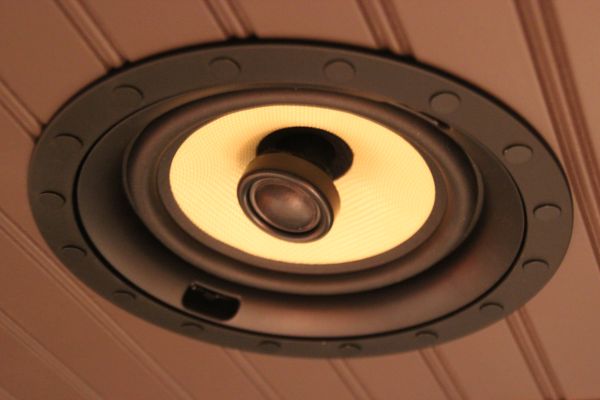
Whenever you're adding speakers to an existing system, it's always a good idea to try to use speakers from the same manufacturer, preferably from the same model line using same size drivers. Cabinet design and construction methods, internal crossovers, and the drivers themselves all work together to give a speaker its tonal character and signature sound. Speakers from the same manufacturer, and particularly those from the same model line, tend to exhibit minimal variation in their tonal characteristics. This is important in a home theater system because you want a consistent quality of sound as objects (e.g. a circling helicopter) pan around the room - or fly directly overhead - transitioning from one speaker to the next.
In the case of my basement theater, I've long been enjoying the sound of seven matching in-walls, the L-55 LCRS, from Nevada-based speaker maker Noble Fidelity. I reviewed them for another outlet back in 2008 and I liked them so much I bought them; they've continued to impress me and my theater guests since then. One of the great things about Noble Fidelity is that they include a complimentary design service, complete with scaled and dimensioned design drawings, with the purchase of their loudspeakers. And as I recently learned, they've also been fully trained by Dolby Laboratories in designing and laying out small-to-large scale Dolby Atmos systems. It should come as no surprise then that Noble Fidelity was my first phone call once I decided to embark on this project.
After telling the good folks at Noble Fidelity about my plan to add four ceiling speakers to my basement theater, I was asked to email them a few photos of my space along with a sketch indicating the key dimensions. The people at Noble Fidelity first confirmed that my existing 7.1 system was laid out in compliance with Dolby Labs' prescribed 7.1 geometry. Next I received from them a scaled diagram of my room indicating Noble's recommended installation locations for my four proposed ceiling speakers. As I learned in speaking with them, Noble Fidelity's Atmos system designs take into consideration the key issues of optimum boundary proximity and support in loudspeaker placement; this means they're careful to ensure that loudspeakers are not positioned too close or too far from reflective surfaces, either of which can be detrimental.
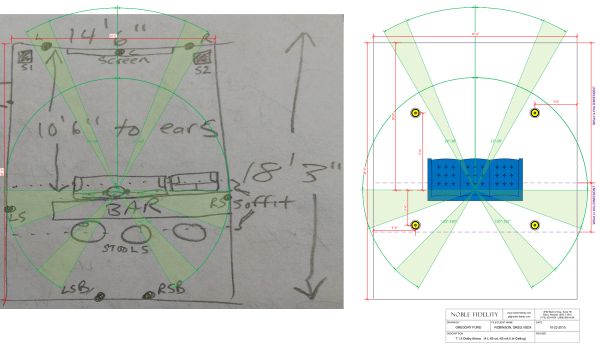
Once we had discussed my current speakers and identified the optimum locations to cut four new holes in my basement ceiling, we settled on Noble Fidelity's L-65 mk IIas the ideal speakers to fill those holes. Compared with the seven LCRS in-walls I was already running, the L-65 mk II features similar-size mid drivers and identical tweeters. This means that, theoretically at least, they should blend nicely with my main speakers whenever overhead sound is called for. (Spoiler alert: they absolutely do!)
And... Cut!
If you install four height channel speakers, the ideal locations for those speakers are going to be in the ceiling slightly in front of and slightly behind your primary seating area. This is what Dolby recommends and, in turn, this is what Noble Fidelity prescribed. Like most ceiling speakers, the Noble Fidelity L-65 mk II comes packaged with a handy cardboard template for tracing its ceiling cut-out hole. In my basement theater, the front height pair posed no problems. The ceiling in front of my sofa is drywall, and there were no unfortunately-located recessed lights to contend with. The rear height speakers were an entirely different story.
In my basement theater, there is a significant overhead beam and soffit enclosure running parallel to my sofa. This soffit occupies - and lowers - a good portion of the ceiling immediately behind my primary seating area. In other words, it's precisely where I want to put my rear height speakers. Installing the rear pair in the drywall ceiling behind the soffit would put the speakers a bit further back than I wanted, and I wasn't sure what the soffit would do to my ability to hear the speakers from the sofa - nothing good, most likely. Thankfully, all was not lost. After this dilemma stalled my project for a short while, a feasible plan eventually emerged, but it would mean some extra work.
I continue to thank Chuck Funk of Funk and Little - the woodworking masters who helped me frame and finish my theater - for his forethought and attention to detail when he built my ceiling soffit. In addition to integrating a convenient shelf for my concealed projector, Chuck convinced me that the entire underside of the soffit should be comprised of removable panels for easier access to wiring and plumbing in the future. And because Chuck integrated the recessed lighting into the panel grid's cross-pieces, the panels themselves are free of obstructions. They're also the perfect size to house an in-ceiling speaker.
Installing the rear height speakers in the soffit's panels proved trickier than it looked at first. The panels themselves are made of thin, lightweight MDF. And while the Noble Fidelity L-65 mk II isn't terribly heavy, the panel seemed incapable of adequately supporting its roughly 6-pound weight. To add some much-needed rigidity to the panels, I glued ¾" thick plywood to the backsides of the two panels in question. This was a process unto itself, during which I had to shave and chisel the plywood in several spots where interior obstructions were preventing the now-thicker panels from lying flat. It wasn't terrible though and in the end, my two panels were reinforced and I used Noble Fidelity's template to cut two holes in my new and improved "ceiling."
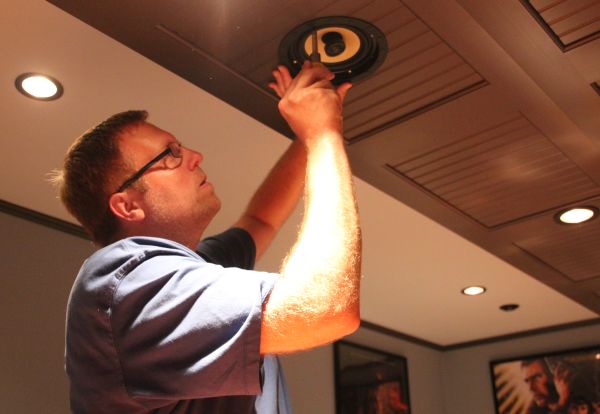
The worst part of any speaker retrofit is typically pulling the speaker wire from A to B. My life was made a bit easier here, again thanks to that soffit. Since the soffit is largely empty, it serves as an excellent wire chase and home run to my audio/video closet, which is adjacent to the soffit. Once I had my four ceiling holes cut, it was quick work to run my wires and prep the holes for speakers. Noble Fidelity ceiling speakers feature beefy, spring-loaded binding posts for wire connections and four fast and easy, swing-out clamps to secure the speaker to the ceiling.
One particularly nice touch Noble Fidelity added to their L-65 mk II speaker is giving you a choice of using round or square grilles; both styles are included in the box. The grilles are paintable - which I haven't gotten around to yet - and they can be easily swapped out thanks to a ring of 16 neodymium magnets around the speaker's outer flange. This means you don't have to pry the grilles out with a paper clip, which can sometimes be a pain, and it also means the grilles don't rattle or buzz. The L-65 mk II's grilles being so easily removeable also comes in handy when you want to experiment with the midrange and high frequency acoustic compensation switches Noble Fideility provides. These 3-position switches are largely "set it and forget it" adjustments - but you'll want to do some experimenting before you set them.
Showtime
Once I configured everything on my Yamaha RX-A3050 A/V Receiver, I was eager to see, err, hear what my efforts had yielded. Luckily, there are quite a few Blu-ray Discs available now featuring Dolby Atmos or DTS:X, the former being more numerous at the time of this writing. The first disc I reached for was Warner's Gravity. Gravity is a remarkable film and I can remember just how visceral my experience was when I first saw it at the local multiplex. Firing up my Diamond Luxe Blu-ray edition (the only release featuring a Dolby Atmos track), my jaw was immediately on the floor.
The first scene in Gravity, during which a routine space walk becomes a horrifying nightmare, is an armrest-gripping assault on the senses. But even before disaster strikes, the magic of Dolby Atmos is immediately evident. Hearing the radio voices of Ed Harris, George Clooney, and Sandra Bullock subtly moving from one channel to the next - first they're in front and then they're above and then they're behind AND above - all while Clooney slowly orbits the shuttle in his jet pack? I was sold before the first piece of debris arrived. Of course, then the debris did arrive and I'm pretty sure I forgot to breathe for the next five minutes. In a word, incredible. Simply incredible.

I played the same scene for my good friend Tom and he too was instantly convinced. You know it's a compelling demo when the first question you get is, "OK, what do I need? Because I need this." My wife and kids were no different. Dolby was kind enough to send me an assortment of discs featuring Dolby Atmos soundtracks as well as an official Atmos demo disc produced by Dolby. My kids couldn't get enough of the brief Atmos ads and intros, all of which feature wonderfully immersive sound effects, such as falling rain, falling leaves, and buzzing fireflies. It sounds cliche, but these immersive height channel sounds add such a fullness to the sound stage, you really don't know what you're missing until you hear the same scene with it and without.
Feeling (and Sounding) Good
Once I moved beyond the initial wow stage of hearing sounds directly over my head, it quickly became evident that the L-65 mk II exhibits a wonderful quality of sound and tremendous range, from a robust midrange to crisp, airy highs. They also blend beautifully with my Noble Fidelity LCRS in-walls - an essential quality for a Dolby Atmos or DTS:X home system. That said, make no mistake: these are no mere effects speakers.
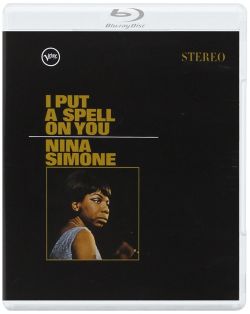
After several days of listening to impressive Dolby Atmos film and music soundtracks, I wanted to give the L-65 mk II an old school stereo music test. After popping in my Blu-ray Audio Disc of Nina Simone's I Put a Spell On You, I promptly skipped to one of my all-time favorite tracks, Feeling Good. An apropos title, because that's exactly how the L-65 mk IIs made me feel.
Incredibly smooth and never straining, the open-backed, infinite baffle L-65 mk II is an incredibly capable loudspeaker. They definitely needed some help from my SVS subwoofer to round out the bottom end, but that's to be expected from virtually any ceiling speaker. According to its published specs, the L-65 mk II will go down as low as 42Hz and I achieved fantastic results setting my crossover at 60Hz. Although I didn't have the opportunity to listen to them vertically in an ear-level, wall mount scenario, I was blown away by the sound stage created by my ceiling-mounted L-65 mk IIs. They completely filled my theater with Nina's soul-stirring music, and seemed to do so without breaking a sweat.
Bottom Line
While it may have been inevitable that I found myself installing four ceiling speakers to take advantage of Dolby Atmos and DTS:X, I never expected to be quite so impressed with these L-65 mk II speakers - though perhaps I should have. After all, I've been loving my Noble Fidelity LCRS in-wall speakers for years now. Why should the L-65 mk II be any different? Now that I've spent some quality time with these round mounts, I can easily envision an entire system - be it 5.1, 7.1, or 7.1.4 - comprised entirely of L-65 mk II speakers. Whether you wish to put them in the wall or in the ceiling, using the round grilles or the square, the L-65 mk II is an impressive loudspeaker worthy of your consideration. Highly recommended.
Manufacturer's Specifications
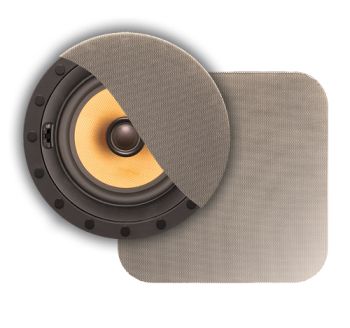
What's in the Box?
More Information
Where to Buy:
| Overall | |
|---|---|
| Value | |
| Performance | |
| Features/Ergonomics |